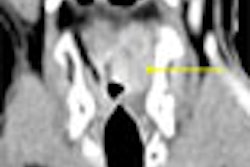With U.S.-based VC researchers focusing their attention on the ACRIN 6664 trial for virtual colonoscopy, it's worth noting that Europe has some major research irons of its own in the fire. Unlike most trials in the U.S. focusing on average-risk patients, the European initiatives aim to recruit patients who are at higher risk of disease.
The British Special Interest Group in Gastrointestinal and Abdominal Radiology (SIGGAR) 1 and the Italian Multicenter Study on the Accuracy of CT colonography (IMPACT) trials are both under way. Over the next few years, their results from multiple centers and with large numbers of patients will influence the practice of colorectal cancer screening in Europe and around the world.
Dr. Stuart Taylor from University College London was in Boston last month to discuss both studies at the 6th International Symposium on Virtual Colonoscopy.
SIGGAR anyone
While the focus of most U.S.-based VC trials has been on finding advanced adenomas before they progress to colorectal cancer, patients in the U.K. tend to suffer from more advanced disease, Taylor said.
"If you look at the U.K. (five-year) survival for colorectal cancer, we're actually very poor at about 42%, which is much less than our European friends and colleagues. People are very slow in the U.K. to come to us with symptoms, and we don't diagnose their colorectal cancer until it's too late."
To provide for earlier diagnosis and treatment, the National Health Service (NHS) is requiring that patients presenting with symptoms suggestive of colorectal disease be diagnosed within two months' time. This has squeezed gastroenterologists' schedules, further increasing the need for VC, Taylor explained.
"There's been a fivefold increase in demand for colonoscopy, polyp follow-up, etc. in the last 15 years, and they're getting swamped," he said. "In the U.K. we're going to have fecal occult blood primary screening for the whole of the population. It's one extra list for the endoscopists every single week ... and they can't really cope with all the patients coming through."
Thus, the current SIGGAR 1 trial is aimed in part at determining if VC can help fill the gap in colorectal cancer detection. Its stated goal is to assess the sensitivity and specificity of CT colonography (or virtual colonoscopy) in the per-patient detection of advanced adenomas or cancer in subjects age 55 and older at risk of colorectal disease.
Many studies have shown VC to be very sensitive, on the order of 96%, for detecting frank colorectal cancers. However, this has not yet been demonstrated in randomized multicenter trials, Taylor said.
"With colorectal cancer, even if you come up with a whole list of symptoms you think may be very sensitive, only about 10% of the patients actually have colorectal cancer ... which is good, but we have to tell them we can't wait for months," he said. "We have to know." To speed up treatment and testing, NHS is requiring that patients presenting with symptoms be examined and diagnosed within two months of presentation.
True to its acronym, SIGGAR 1 is being conducted under the auspices of the Royal College of Radiology Special Interest Group in Gastrointestinal and Abdominal Radiology, in collaboration with Research U.K., the University of Birmingham, and the University of Nottingham. It is being coordinated by Dr. Steve Halligan and Dr. Wendy Atkin, and funded by the NHS' technology assessment program, Taylor said.
The trial compares virtual colonoscopy with conventional colonoscopy and barium enema, which is still very popular in Europe. When performed correctly, barium enema can find about 85% of colorectal cancers and about 70% of advanced adenomas. But a national screening study found that sensitivity was just 48% for lesions greater 1 cm, Taylor said, so it may not be that good in practice.
For conventional colonoscopy, a study last year found that the cecal intubation rate was extremely low at 57%. That means that just over half of all conventional colonoscopy exams in the U.K. are completed, a finding that has led to increased investment in training for endoscopists, he said.
SIGGAR 1 actually comprises two parallel multicenter randomized arms: VC compared to same-day segmentally unblinded conventional colonoscopy, and barium enema compared to virtual colonoscopy. When a patient presents with symptoms, the clinician will decide whether to refer the patient for barium enema or colonoscopy for the initial exam. After that exam the patients in both arms will be randomized to undergo either colonoscopy or virtual colonoscopy.
The study has a statistical power of 90% to detect differences in sensitivity, so if either VC or colonoscopy varies by more than 5%, "we'll pick that up," Taylor said. However, because the sensitivities of virtual and conventional colonoscopy are roughly similar, thousands of patients are needed to achieve adequate power for the end points.
Both endoscopists and radiologists will be fully trained in their respective techniques. Operational and patient preference issues will be considered in addition to absolute diagnostic performance.
That means the team will examine "how many times (patients) have to come to the hospital, how many blood tests they need, how many times they have another investigation, and how they feel about all these tests," Taylor said. The impact of extracolonic lesions, 2D versus 3D (radiologists choose the reading method and software), and even CAD will ultimately be assessed and documented on the Web-based patient management system. Approximately 1,000 patients have been recruited so far.
The study aims to screen about 4,500 patients at 15 centers, six of which are up and running. More than 1,000 patients have been recruited so far, and the group hopes to report the results in 2007, Taylor said.
IMPACT on colon cancer
In Italy, a second multicenter VC trial is being coordinated by Dr. Daniele Regge and colleagues at Istituto per la Cura e la Ricerca sul Cancro (IRCC) in Candiolo, Italy, and the nearby University of Turin.
IMPACT aims to assess VC's per-patient sensitivity and specificity for advanced adenomas or colon cancer in subjects at increased risk of the disease.
The three categories of subjects will include: 1) first-degree relatives of patients (ages 40 to 65) with confirmed advanced adenomas or colorectal cancer, 2) patients (ages 18 to 70) with a personal history of polypectomy undergoing follow-up, and 3) subjects ages 59 to 69 with positive fecal occult blood test (FOBT) results from a regional FOBT screening center, Taylor said.
Four liters of a polyethylene glycol (PEG) electrolyte solution will be given for bowel cleansing. A liquid diet is permitted on the evening before the exam. Room-air insufflation, administration of n-butlyscopolamine as an antispasmodic, and thin-section MDCT with a primary 2D read (and 3D problem-solving) are additional components of the protocol.
Two VC experienced radiologists and two experienced endoscopists from each center will interpret the results, with demonstrated proficiency required for both groups, Taylor said.
At colonoscopy, polyps will be categorized as diminutive, small, and large. At VC only polyps 6 mm and larger will be reported to limit the number of false positives. The trial will also track "how many times colonoscopy misses lesions that CT sees first, costs, interobserver variability, and whether primary 2D or 3D is the best way to interpret the results," patient acceptance, and the frequency impact of extracolonic findings, he said.
The investigators aim to disprove the hypothesis that virtual colonoscopy's sensitivity is less than 70% for advanced adenomas, defined as 10 mm or larger and/or with a 20% villous component, suggesting that the true figure is approximately 80%. Also assuming that 150 subjects with advanced lesions will be found at double-read virtual colonoscopy, the study will provide 90% power of rejecting (at a one-sided level of significance) the 70% sensitivity hypothesis.
"So as long as CT performs better than 70%, they're powered to show that it's as least as good as colonoscopy," Taylor said.
The number of patients needed to prove this "very much depends on where the patients come from," he added. "Patients coming from the FOBT-positive cohort have a very high incidence (approximately 50%) of these advanced lesions, whereas if most of the patients come from the postpolypectomy follow-up group, perhaps about 4% will have advanced adenomas. So obviously the more (FOBT) patients you get the less you need, and the more (postpolypectomy) patients you get the more patients you need."
Close to 200 patients have been recruited so far, Taylor said.
By Eric Barnes
AuntMinnie.com staff writer
November 22, 2005
Related Reading
Colorectal cancer screening not necessarily right for elderly, November 15, 2005
Reading method, insufflation affect polyp measurements, November 14, 2005
VC holds up against back-to-back colonoscopies, July 19, 2005
Prepless VC yields high sensitivity in average-risk subjects, June 10, 2005
VC experts have an edge over less experienced readers, March 8, 2005
Copyright © 2005 AuntMinnie.com




















